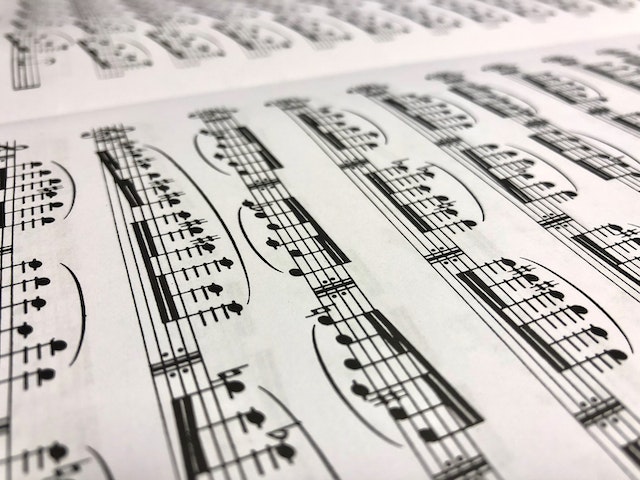In the first article on printing the focus was on printing in general, on the history and the techniques. In this second part we turn our attention to a more specific area, on printing music and music publishing. In the last part of this article there is a complete list and short history of each music publisher that were in business association with Beethoven.
What to print?
The history of music publishing starts with the birth of musical notations. These are symbols representing sounds, duration, rest and tempo organized into a complex system that is the embodiment of a musical piece. This was not, and in fact is not, a unified system across civilizations and history. Not only were the notations different, but far from comprehensive. The earliest musical notation found so far is from ancient Babylonia from about 1400 BCE, engraved into a stone tablet. In ancient Greece manuscripts containing musical notations were produced for education and public performances.
The roots for what later became the modern Western notation are in medieval Europe. The Christian Church made significant efforts to unify their worship throughout the ecclesia. First, for plainchant melodies, later for more complex polyphonic hymns the church needed a more comprehensive solution in notations. In the different coming ages from the Renaissance through Classical and Romantic music eras, even in the 20th century, musical notation has been developing and mirroring the latest developments in instruments and music making.
Music publishing
Prior to mechanical printing techniques and mass production, music scores had to be created and copied by hand. This was a very labor intensive activity and the end result was almost never perfect. Again, the Church was heavily involved in this activity, monks and priests worked steadfastly copying sacred liturgical music. Manual copying remained in practice even after the invention of Gutenberg’s printing machine. Hundreds of years later, well into the 18th century, manually copied scores were still commonplace. Before the time of dedicated music publishers and copyrights in general, music was regarded as a gift from above and composer rights to monetization was a novel idea. Such manual copiers time-and-again were caught stealing works and selling them even before the official premiere.
|Related: The music business of the 19th century
The first notable European printer who pressed music was Ottaviano Petrucci from the 16th century Venice. He used the triple-impression method, one for staff lines, one for words and finally the notes. John Rastell from England and Pierre Attaingnant from France soon followed this pioneer.
Music publishing, as we know it today, has played a pivotal role in shaping the music industry and providing a platform for composers and songwriters to share their creations with the world. First, back in the Baroque and Classical periods significant developments happened in music publishing. Composers such as Johann Sebastian Bach, Handel or Antonio Vivaldi worked closely with publishers to release their compositions. The role of music publishers soon expanded from only printing scores to arranging performances and promoting the works of composers.
The Classical era of Haydn, Mozart or Beethoven saw the emergence of music journals and newspapers. These reviewed and often advertised new compositions, bringing composers and audiences closer. In this era publishers financing a piece in advance also became commonplace.
The 19th century is often referred to as the “Golden Age of Music Publishing.” In this era many prominent music publishing houses established themselves, including Breitkopf & Härtel, Peters, and Schott. These publishers also contributed to the standardization of musical notation, making it easier for amateur and professional musicians to perform or interpret compositions. European born music was distributed, for the first time, worldwide.
The 20th century made music publishing even more complex. Publishers had to adapt to new mediums, such as phonograph records, radio and lately digital. Their work involves not only the publishing, but covers copyrights, licensing and performance rights. Digital distribution and streaming have reshaped the way music is published and consumed. Some providers will offer – even considering only classical music – over a 100 million songs (!) allowing access to an unprecedented catalog of music.
Music publishers of Beethoven
As I was composing this article I had become truly amazed when discovered with how many publishers Beethoven was associated with. I am convinced this list is complete with those who published as least one composition. The total number is fourteen! This shows how lively the music industry was even back in the 18th and 19th century!
In the following part this article will cover each of them with a short introduction.
Breitkopf & Härtel
Breitkopf & Härtel is one of the oldest and most prestigious music publishing companies in the world. It was founded in Leipzig, Germany in 1719 by Bernhard Christoph Breitkopf, later joined by Gottfried Christoph Härtel. It has played a significant role in the dissemination of classical music and the development of music printing and publishing. It became known for publishing the works of renowned composers such as Johann Sebastian Bach, Wolfgang Amadeus Mozart, Ludwig van Beethoven, Franz Schubert, and many others. Breitkopf & Härtel played a crucial role in the production of scholarly editions of classical music.
It has survived through centuries, wars and political changes, operating even today in our digital era.
Their website: www.breitkopf.com
Artaria
The Artaria enterprise was founded in 1770, Mainz (Germany) by Giovanni Artaria and his nephews Carlo and Francesco. He was an Italian-born musician and music dealer. At the time Vienna was a vibrant center for music and culture, and Artaria recognized the growing demand for printed music. After moving to Vienna, Artaria became well-known for its publications of works by Wolfgang Amadeus Mozart and Joseph Haydn. Artaria was one of the early publishers of Ludwig van Beethoven and despite business related disputes and breaks in the cooperation even some of the last pieces of his compositions were published by Artaria, such as the Hammerklavier Sonata in 1819 and the composer’s Große Fuge in 1827.
The music publishing business was later purchased by Diabelli, but still in 1858 it went out of business. Its map-publishing business operated well into the early 20th century.
Simrock
The company was founded by Nikolaus Simrock in Bonn, Germany, in the late 18th century. They were famous for publishing Brahms’ and Dvorak ‘s works in the 19th century, but first and foremost being a close friend and publisher of Beethoven. It published some of Beethoven’s most iconic works.
Unfortunately, many of the company’s archives and plates were lost in the Second World War and had to be reconstructed from prints. The company was sold many times during its long operation and now is owned by Boosey & Hawkes, the world’s largest classical music publishing company.
Their website: www.boosey.com
Hoffmeister & Kühnel
Franz Anton Hoffmeister had studied law in Vienna, later composed music, but is remembered mainly through his music publishing business that he established in 1785. This and his second company, Bureau de Musique, founded together in Leipzig with Ambrosius Kühnel was comparable to Artaria in influence.
Hoffmeister, probably to have time for his composing, later sold his shares in both companies. The Leipzig enterprise completely went to Kühne and his Viennese to the publisher Chemische Druckerey. The Bureau de Musique was later acquired by Carl Friedrich Peters (a book publisher at the time).
George Thomson
George Thomson was born in Limekilns, Fife, Scotland, in 1757. He worked as senior clerk to the Board of Trustees for the Encouragement of Art and Manufactures in Scotland, but he dedicated his leisure time to music. He sang, played the violin and was involved in concert promotion.
In the 1780s, performances of Scottish songs inspired him to embark on a lifelong project of collecting folks songs. Between 1793 and 1841 he published six volumes of Scottish airs, three of Welsh airs and two of Irish airs, each volume containing about 50 songs.
Thomson’s lifelong collaboration with Beethoven was particularly noteworthy. Beethoven composed several arrangements for Thomson’s collection, including “Scottish Songs” and “Irish Songs.” These arrangements showcased Beethoven’s skill in adapting folk melodies for piano and voice. The two had their disagreements time-and-again as Thomson politely tried to convince the composer to give up his artistic freedom and go for more simple compositions, keeping in mind the needs of amateur music enthusiasts.
Thomson continued his work as a music publisher and collector throughout his life.
Ignaz Pleyel
Ignaz Pleyel was born in Ruppersthal, Austria, in 1757 and had 18 siblings (in some sources even more!). Not only was he a talented musician (studied under some notable composers of the time, including Joseph Haydn), a famous piano maker (Frédéric Chopin considered Pleyel pianos the best), but also a music publisher.
He established his publishing business, Maison Pleyel, in 1797, Paris. The company existed for almost 40 years and published some 4 000 works.
In 1805 Pleyel had visited Vienna where he met (for the last time) his old master Haydn and also met Beethoven.
The legacy lives on even today as piano makers: www.pleyel.com/en/
Muzio Clementi
Muzio Clementi was a renowned Italian composer, pianist, and music publisher. He was born in Rome, Italy, in 1752. In 1766, Clementi traveled to England to study music further. England became his adopted home, and he spent most of his life there. He quickly gained recognition for his piano virtuosity and composition skills. He ventured into music publishing in 1798, when he established his own music publishing firm in London, Clementi & Co.
Clementi held rights for all the works of Beethoven for publishing in England. Interestingly, similarly to Pleyel, Clementi also manufactured pianos with significant success.
Sigmund Anton Steiner
Sigmund Anton Steiner was a man of remarkable talent who embarked on his career as a writer and secretary. He steadily ascended the ladder to become a prominent Viennese publisher. In the year 1803, he made the move by acquiring the print shop previously owned by Alois Senefelder, the visionary behind lithography technique. Steiner also crossed paths with the renowned Ludwig van Beethoven. Throughout the 1820s, his company played an important role in introducing many of Beethoven’s compositions to the public.
Adolf Schlesinger
He was born as Aaron Moses Schlesinger, in Biała, Silesia, and was of Jewish descent. He ventured into the world of books in 1795, Berlin, where he initially operated the business from his residence. In 1810, he established the Schlesinger’sche Buchhandlung, a music publishing house. Over the subsequent decades, the company flourished, attracting renowned composers such as Ludwig van Beethoven, Felix Mendelssohn, and Carl Maria von Weber. Additionally, it served as the publisher for military music commissioned by the Prussian state.
Schlesinger’s persistent advocacy for musical copyright protection, driven by copyright violations related to his publication of Weber’s “Der Freischütz,” played a pivotal role in the enactment of the influential Prussian copyright law of 1830.
|Related: Music copyrights in Beethoven’s time
Schlesinger’s Jewish heritage resulted in derogatory remarks directed at him by certain fellow publishers and composers of his time. The publisher Peters for example had discouraged Beethoven from entrusting Schlesinger with his Missa Solemnis, arguing that ‘a Christian Mass composed by Beethoven should not be handled by a Jewish individual, especially one like Schlesinger.’ However, despite these prejudiced sentiments, Beethoven had no qualms about allowing Schlesinger to publish his late quartets and sonatas afterward.
In 1838, Schlesinger passed away in Berlin. Following his father’s footsteps, Schlesinger’s son, Moritz Adolf (known as Maurice) Schlesinger, went on to establish a branch of the family business in Paris that became a leader in good musical taste. His other son, Heinrich, took control of the Berlin branch, eventually selling it to Robert Lienau in 1864.
Peters Edition
Peters Edition was established in Leipzig, Germany, in 1800 by Franz Anton Hoffmeisterand. The company initially operated under the name “Bureau de Musique”. In 1818, the publishing house changed hands and Carl Friedrich Peters took ownership. He renamed the company to “C.F. Peters” and continued to expand its music catalog. The company enlarged its operations beyond Leipzig, establishing branches in other European cities, and even New York.
Today, Peters Edition, now known as “Edition Peters,” remains a respected name in the music publishing world.
Their website: www.wisemusicclassical.com/publishers/edition-peters/
Diabelli
Anton Diabelli (1781-1858) was a versatile Austrian figure in the world of music, known for his roles as a music publisher, editor, pianist, guitarist, and composer.
In 1817, Diabelli took a significant step by establishing his own music publishing enterprise. Just a year later, in 1818, he entered into a partnership with Pietro Cappi, giving rise to the renowned music publishing firm, Cappi & Diabelli.
Diabelli’s publishing house thrived and expanded over the course of his lifetime, a testament to his dedication and vision. His active involvement continued until his retirement in 1851 when he entrusted the reins to Carl Anton Spina.
One of Diabelli’s most notable achievements was his involvement with the “Vaterländischer Künstlerverein,” (Patriotic Artists’ Association) a collaborative project that aimed to create a collection of variations on a theme composed by Diabelli himself. He invited several prominent composers of the time, including Ludwig van Beethoven, Franz Schubert, and Johann Nepomuk Hummel, to contribute variations.
Beethoven’s work for the “Vaterländischer Künstlerverein” project was the famous “33 Variations on a Waltz by Anton Diabelli,” commonly known as the “Diabelli Variations.” Beethoven’s set of variations is regarded as one of the most significant works in the piano repertoire.
Schott Music
Schott Music was founded in Mainz, Germany, in 1770 by Bernhard Schott, making it one of the oldest music publishing houses in existence (it is the second oldest music publisher after Breitkopf & Härtel). It originally operated as a general publishing firm, producing books, sheet music, and other printed materials. In the early 19th century, Bernhard Schott’s grandson, Matthias Schott, transitioned the company’s focus to music publishing.
Schott Music boasts a diverse repertoire that spans classical and contemporary genres, encompassing compositions by renowned maestros like Beethoven, Schubert, and Chopin.
Moreover, Schott Music serves as a representative of significant composers from both the 20th and 21st centuries. Their catalog includes the works of Hindemith, Stravinsky, Orff, Schoenberg, and Henze.
With a global presence, Schott Music maintains offices in numerous countries worldwide, including the United States, the United Kingdom, and Japan. For almost 250 years, Schott has been writing history in music.
Their website: https://www.schott-music.com/en
Tobias Haslinger
Tobias Haslinger was born in Pressburg, which is now Bratislava, Slovakia, in 1787. He later moved to Vienna, Austria, where he became a central figure in the city’s musical life. Initially he had only worked for Sigmund Anton Steiner and his publishing company, but later became a partner. Haslinger had a very friendly relationship with Beethoven which lead to many important common publishing projects.
Probst
In the year 1823, Heinrich Albert Probst (1791-1846) established his publishing firm in Leipzig, featuring a catalog that included many prominent composers of the era. Thirteen years later, Probst decided to pass the reins, selling the business to Carl Friedrich Kistner (1797-1844), resulting in the company’s renaming as “Kistner.”
Probst later took on the role of Breitkopf’s Paris representative, procuring rights for works by composers like Chopin and others on their behalf. Under Kistner’s stewardship, the firm experienced substantial growth, incorporating compositions by contemporary German artists such as Schumann, Mendelssohn, Moscheles, Gade, Joachim, and Hiller.





